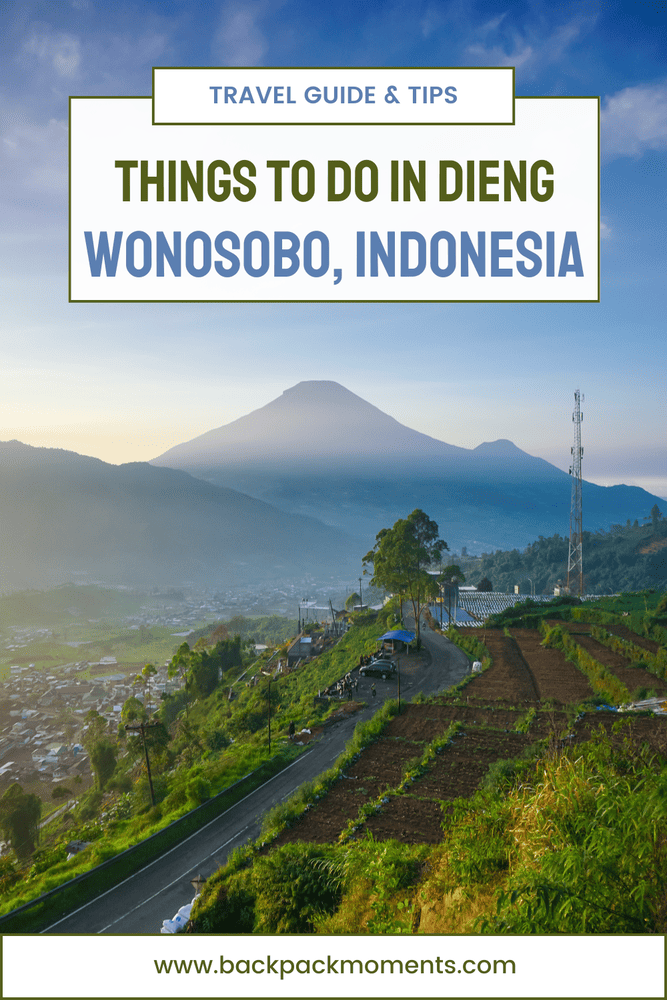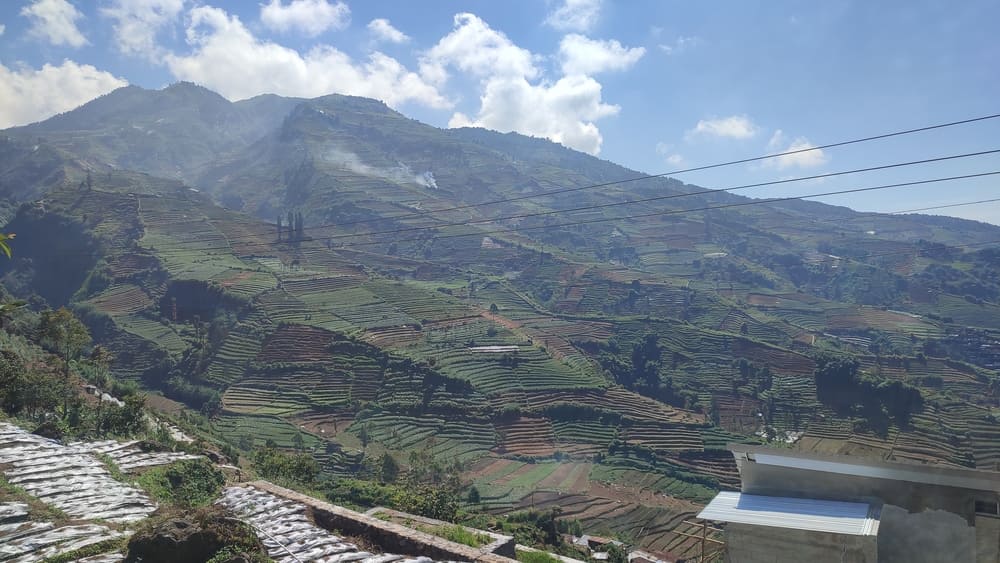Dieng Plateau in Java: A Detailed Travel Guide
This post may contain affiliate links. If you make a purchase using one of these links, I may receive a small reward at no extra cost to you. See my Disclosure Policy for more information.
Java hides so much.
Take the Dieng Plateau, for example. It ticks all the boxes – breathtaking views, scenic nature, rich heritage, volcanoes, tea plantations, unique food, and a cool climate.
Yet, foreign backpackers mostly don’t know it. Domestic tourists love it, though.
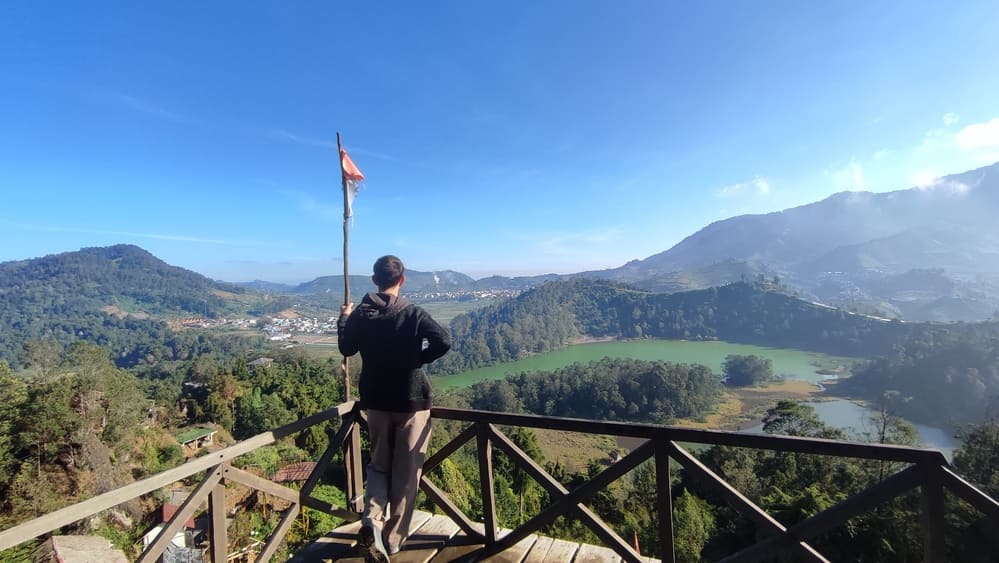
Look, most have heard about the dazzling waterfalls Tumpak Sewu and Madakaripura, as well as the awe-inspiring volcanoes Bromo and Kawah Ijen.
So this guide is my attempt to put the Dieng Plateau in the backpacker crosshairs in Java.
Dieng Plateau is part of my 14-day Java Backpacking Itinerary.
What is the Dieng Plateau?
Take a volcano. Then add a few more next to it. Now you have a Volcanic Complex. All these volcanoes have calderas. A caldera is a flat depression around a volcano. Combine all the volcanoes’ calderas, and you get a plateau.
Dieng Plateau is a volcanic complex about 6 km long and 14 km wide. It is the highest plateau on Java (up to 2565 meters !). It’s the only place in Java where you have a slight chance of experiencing snow in July/August!

At the north end of the plateau is the city of Dieng, considered the coldest city in Indonesia outside of Papua.
The name Dieng means “the place where the gods reside” when translated from Javanese. The locals more commonly call the area “the land above the clouds“.

How to get to Dieng Plateau
Dieng has no train station, so you have 2 main options for getting there:
- By bus. First to Wonosobo, then a regional minibus to Dieng.
- By motorcycle for freedom and flexibility.
How to get from Yogyakarta to Dieng Plateau by public transport
First, make your way to Terminal Jombor in the northwest of Kota Yogyakarta. Many of the Trans Jogja public buses go there at 3600 IDR / 0.24$ per ticket. You can also take a Grab/GoJek taxi.
You can buy one directly at any bus stop (halte), and the attendant will tell you which bus to take.
At Terminal Jombor, take a bus bound for Wonosobo. It costs 60.000 IDR. Regional buses in Java do not operate on a set schedule, so you may have to wait a while.
If there’s no bus to Wonosobo, you can also take a bus to Magelang. There’s usually one every hour which costs 30.000 IDR (~2$).
In Magelang, frequent buses go to Wonosobo for 30.000 IDR / 2$ again.
The biggest Buddhist temple in the world – Borobudur – is in Magelang, so it’s worth combining the two. See how to watch the sunrise on Borobudur!
Once you reach Wonosobo, take the regional minibus going to Dieng. This one is relatively frequent, and you can take it anywhere on the main street between Wonosobo and Dieng (Jalan Dieng).
It costs 20.000 IDR (~1.3$) and 1.5 hours later you will be in Dieng.
Tours to Dieng Plateau
Going by public transport is a bit of a hassle, to be honest. The buses are slow and not very comfortable. And you may not be willing to ride a scooter all the way to Dieng (at least 4 hours from Yogyakarta).
That’s why I think some organized tours to the Dieng Plateau are worth the money. Moreover, the places of interest are spread around the Plateau, which is just too large to walk around in a day, so some form of transport is required.
I recommend these:
- Dieng Plateau Sunrise Tour from Yogyakarta: Includes all places inside the Plateau and covers all entrance fees. Best value for money.
- Dieng Plateau Day Trip: Customizable trip with transport from Yogyakarta.
- Dieng Plateau 2D/1N with a visit to Borobudur: For those who want to visit all the temples!
If you want an even cheaper tour, go to Tugu Monument in Jogja [map] and look for the local tour operators. Some of them offer organized tours to the Dieng Plateau. Negotiate on-site.
What to see and do in Dieng Plateau
Dieng Plateau offers a mixture of lakes, peaks, volcanoes, temples, and markets.
The thing is, the Plateau is a large area with attractions scattered around, making it hard to reach on foot. If you want to visit everything on the list, you’ll need to walk around 23 km.
Having a scooter solves this – if you aren’t coming by one, you can rent a scooter in Dieng.
Also, tours will have transport between the different places organized. Check my recommendations above.
1. Watch the sunrise at Sikunir Peak
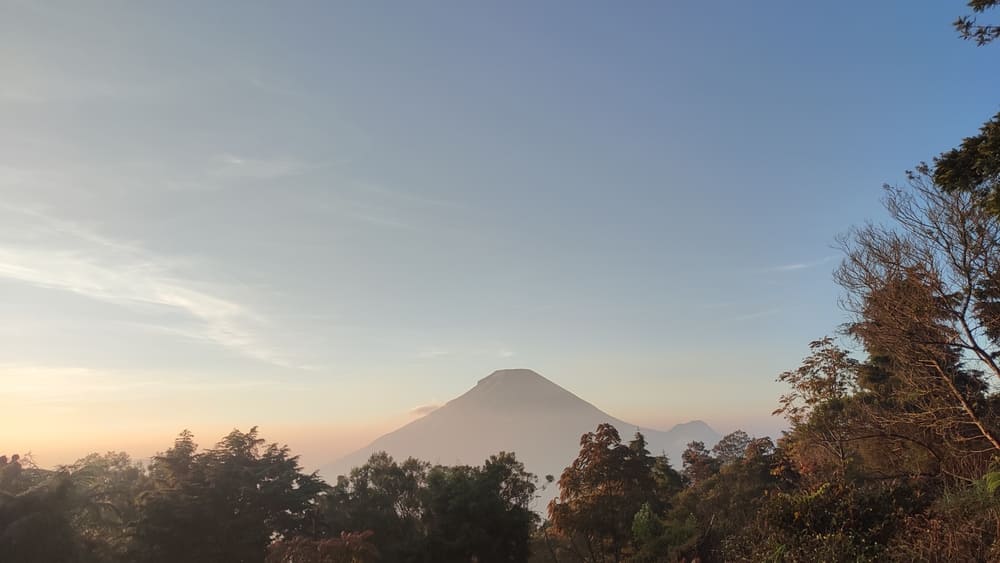
This is hands-down the most popular place in the Dieng Plateau. So much so that on the weekend, there are so many people gathered to watch that it’s almost impossible to walk around freely.
Pro Tip: If possible, go to the Dieng Plateau outside the weekend!
I went there on a Sunday, and I felt like the real attraction wasn’t the sunrise, but the sheer number of people scrambling to find a good spot for their Instagram story. Unfortunately, this is the modern-day reality of overtourism and social media.

Sunrise at Sikunir Peak is between 5:11 and 5:54, depending on the month.
Aim to be at Sikunir Parking Grounds by 4:45. From there, you’ll pass through the market selling typical foods from the region:
- carica (akin to baby papaya)
- fried or boiled potatoes
- coconut cakes
- gorengan (fritters)
After the market starts a trail to the top of Mount Sikunir. This short trek takes about 20 minutes.
The entrance fee for the village of Sikunir is 15.000 IDR / 1$.
2. Check out the lakes
There are two famous lakes in the Dieng Plateau:
- Telaga Warna translates to “Colorful Lake,” and there’s a reason for that. The lake can appear in many different colors – blue and green, of course, but also red, white, and purple. The colors change throughout the day because of the varying sulfuric content.
- Telaga Pengilon isn’t as colorful, although it’s connected to Telaga Warna. Their waters don’t mix, which makes the place unique.
PRO TIP: Don’t enter through the main entrance to see the lakes at eye level. Not only is it not as impressive, but it has a ridiculous price for foreigners.
Locals pay 22.000 IDR there.
Foreigners pay 117.000 IDR on weekdays (7.8$) or 164.000 IDR on weekends (11$).
The lakes are better observed from one of the viewpoints.
There are two viewpoints from which you can see the lakes. The first one is Batu Pandang on the south side, and the other is Sidengkeng Petak 9.
I recommend Batu Pandang.
You can get to Batu Pandang by scooter or hike from the main road passing by the Dieng Volcanic Theater.
Five minutes later, you’ll be at the gate where the entrance fee is 15.000 IDR / 1$ for locals or 50.000 / 3.35$ for foreigners.
3. Smell some sulfur at Kawah Sikidang Crater

You may have seen other sulfuric-releasing craters like the one in Kawah Ijen. In this case, Sikidang will be underwhelming. It’s just not of the same scale.
That isn’t to say it’s not a cool natural phenomenon. A fenced but open crater with the sulfur steam coming out and covering it like the top of a hot cup of tea.
You don’t need a gas mask, nor a surgical one. It smells sulfuric, but is safe and not that much anyway.
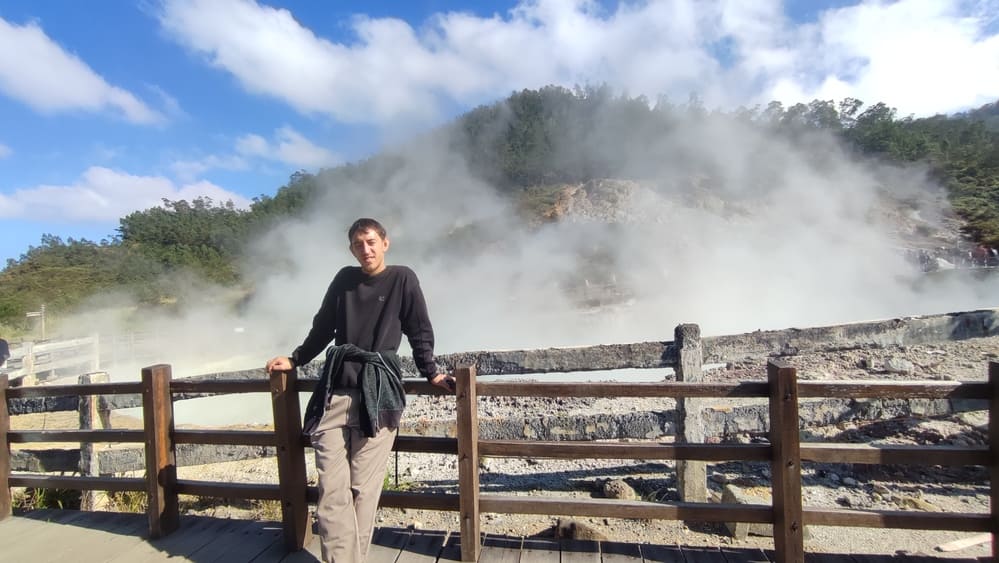
Kawah Sikidang is about 1.5 km from Telaga Warna, and there’s a parking lot in front. Parking fees are standard in Indonesia – you will pay 3.000 to 5.000 IDR (~0.2-0.3 USD) every time you leave your scooter somewhere.
The entrance ticket to Kawah Sigidang also allows access to the Candi Arjuna complex and costs 15.000 IDR for both locals and foreigners. Yeah, finally no price discrimination!
Whoever created the route map for this attraction had the genius (read: “marketing-evil”) idea to twist it around the market at the end.
To exit, you must go through 6 lanes of market stalls, and there’s no shortcut! It’s not even an authentic market – it’s clearly set up to sell to tourists. Eh, well, you can still enjoy some baked potatoes.
4. Visit Candi Arjuna Complex
Your ticket to Kawah Sikidang also includes the Arjuna Temple Complex!
Candi Arjuna is the earliest Hindu temple in Java! It was built in the 8th century and is reminiscent of the Prambanan Temple near Yogyakarta.
They have similar aesthetics, but Candi Arjuna and the surrounding minor temples are tiny compared to Prambanan.
You only need 20 minutes to walk around the Arjuna Complex. It has two entrances – one towards Dieng and one towards Kawah Sikidang.
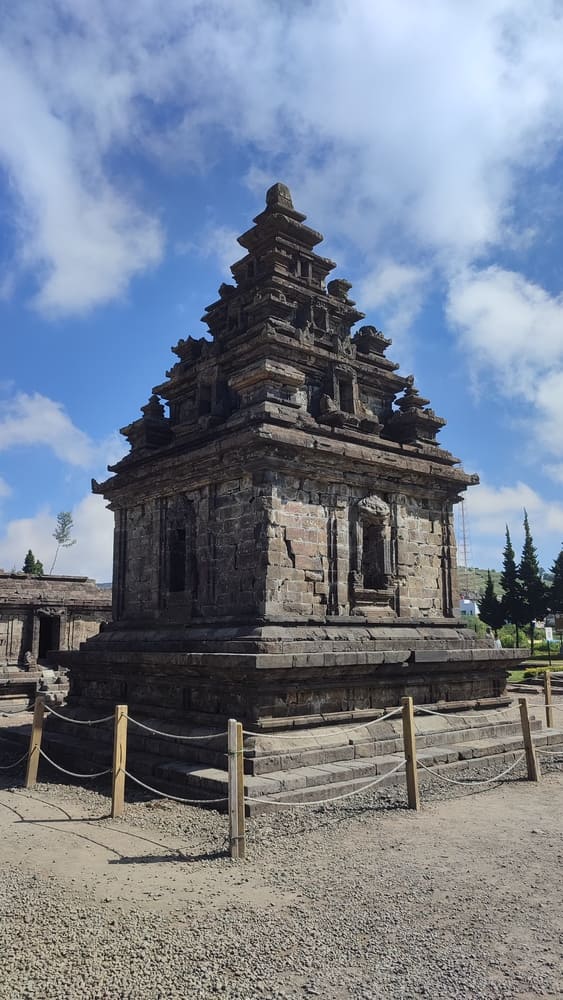
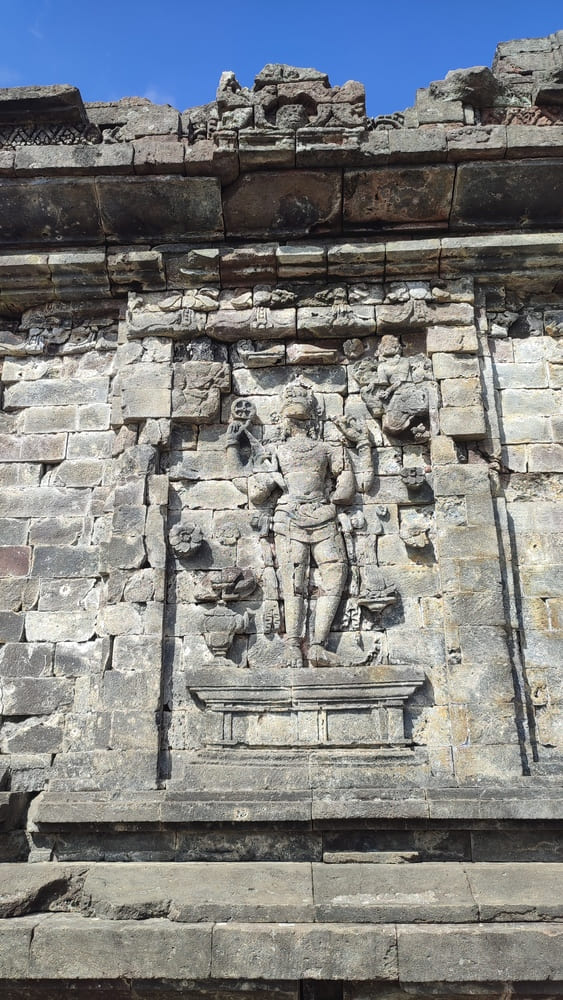
5. Walk around the potato fields and the rice terraces
The Dieng Plateau’s primary agricultural produce is the potato. In recent years, potato production has really picked up the pace to the extent that agriculture now endangers the cultural heritage of the area.
Potato fields literally surround Candi Arjuna and are found all around the Dieng Plateau.
There are wooden tracks connecting different patches of fields that the locals use as shortcuts. You’re more than welcome to use them too!
As you look around, you’ll notice that the area has quite a few rice terraces too. Those beautiful slopes of rice fields… Southeast Asia at its core!
6. Buy traditional local food at the markets
Dieng’s elevation creates a favorable climate for some foods not widely produced in Java.
Some of those locally-produced foods are:
Carica
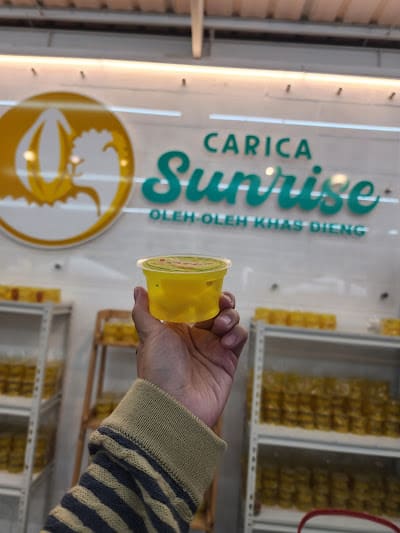
Carica is similar to a baby papaya. It is sold both fresh and packaged and is a popular gift to bring back.
The original high-quality carica costs 3.500 IDR per serving, or 20.000 IDR per 6 cups, or 50.000 IDR per 18 cups. Don’t pay more and haggle if the vendors quote higher.
Lower quality carica (whatever that means, I wasn’t able to figure out the difference, I think it has to do with sugar and additives) is sold in the same cups and also in different colors at a rate of 15.000 IDR per 18 cups.
Check out more Indonesian desserts that you should try!
Mie Ongklok
It’s the Wonosobo/Dieng interpretation of the standard mie dish across Indonesia. Mie Ongklok is sweeter, has cabbage, and is floating in a thick curry called “loh”.
It’s usually served with beef sate and tempe kemul.
Tempe Kemul
In Indonesian cuisine, tempe goreng is everything! It’s fried, crunchy, lightly fermented soybeans.
Its softer brother is the mendoan.
Finally, the temple kemul is a turmeric-infused variation found in Wonosobo and Dieng.
Terung Belanda Jus (Dutch Eggplant Juice)
Even though this plant comes from the Amazon in South America, it carries the name “Dutch Eggplant” in Java, because the Dutch brought it in the 1940s.
It’s from the family of the eggplant, but is way smaller and sweeter, and looks like a big plum. In Dieng, they make juice out of it, which is a local specialty.
Potatoes
Do you need a description of that? Just grab a cup of boiled baby potatoes with sweet sauce and enjoy the sunrise over the Dieng Plateau!
What to wear at Dieng Plateau
Dieng is high! HIGH! Don’t underestimate the cold! Sometimes in July and August, it even snows in the early mornings!
If you’re going for the sunrise, then a winter jacket is highly recommended. A scarf, gloves, long pants, and a hat are also a good idea.
Layer your clothes, because once the sun goes up, it gets progressively warmer and warmer, so you’ll need to remove some of the clothing.
Where to stay in Dieng Plateau
You can either stay in Wonosobo or Dieng. The closer your guesthouse is to Dieng, the longer you can sleep before leaving for the sunrise in the middle of the night.
In Dieng (the town), there are so many guesthouses that you would struggle to pick. Many of them are not listed online. Turn up, ask, and rent for the night on the spot.
Expect to pay between 150.000 and 250.000 (10 to 16.7$) for a double room.
I stayed at Harumi Dieng, which is around 20 km from Dieng, so I only recommend it if you go by scooter.
It’s a very cute guesthouse in a traditional style with a friendly owner serving awesome food.
Where next?
If you’re westbound, you may want to go to Bandung – Java’s trendy fashion capital.
If you’re eastbound, consider a stop in Semarang – a mix of Chinese heritage, colonial remnants, and Javanese culture.
Of course, if you haven’t yet been to Yogyakarta, definitely visit it!

